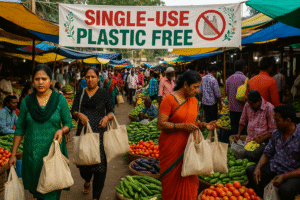Imagine a world where farmers are not just food producers but also climate heroes. Welcome to the world of carbon farming, where agriculture becomes a solution to climate change rather than a contributor.
In India, where agriculture forms the foundation of the economy, carbon farming presents a game-changing opportunity. By adopting practices that enhance soil health and capture atmospheric carbon dioxide (CO₂), farmers can improve their yields, earn additional income, and contribute to a healthier planet.
What Is Carbon Farming?
Carbon farming involves farming techniques designed to boost carbon capture in soil and plants. These approaches not only cut down greenhouse gas emissions but also enhance soil fertility and moisture retention. Wikipedia
Key Practices in Carbon Farming:
- No-Till Farming: Minimising soil disturbance to maintain its carbon content.
- Cover Cropping: Planting crops like legumes during the off-season to enrich the soil.
- Agroforestry: Integrating trees into farmland to enhance biodiversity and carbon storage.
- Composting: Using organic waste to improve soil structure and nutrient content.
- Biochar Application: Adding charcoal-like substances to soil to lock in carbon.
Carbon Farming in India: A Growing Movement
India is witnessing a surge in carbon farming initiatives. With over 50 active projects and a developing domestic carbon market, the country is poised to become a leader in this sustainable practice. Taylor & Francis Online
Case Studies:
- Maharashtra and Telangana: Farmers have adopted carbon farming techniques, leading to improved soil health and crop yields. CGSpace
- Varaha Initiative: Led by Madhur Jain, Varaha has onboarded over 80,000 farmers across South Asia and Africa, covering 700,000 acres and sequestering an estimated 1.7 million metric tons of CO₂. Time

Benefits of Carbon Farming
Environmental Benefits:
- Carbon Sequestration: Captures atmospheric CO₂, mitigating climate change.
- Soil Health: Enhances soil structure, fertility, and water retention.
- Biodiversity: Promotes diverse ecosystems through agroforestry and cover cropping.
Economic Benefits:
- Carbon Credits: Farmers can earn additional income by selling carbon credits.
- Reduced Input Costs: Lower reliance on chemical fertilisers and pesticides.
- Resilience: Improved soil health leads to better yields, even in adverse weather conditions.
Challenges and Considerations
While carbon farming holds immense promise, it is not without challenges:
- Initial Investment: Transitioning to carbon farming may require upfront costs for new equipment or training.
- Measurement and Verification: Accurately quantifying carbon sequestration can be complex.
- Market Access: Navigating carbon credit markets requires support and knowledge.
Addressing these challenges necessitates collaborative efforts between governments, NGOs, and the private sector to provide resources, training, and financial incentives.
Conclusion
Carbon farming represents a paradigm shift in agriculture, transforming farmers into stewards of the environment. By embracing carbon-sequestering methods, Indian farmers can become key players in the fight against climate change while also improving their economic well-being.
Author’s Note
As someone deeply passionate about sustainable agriculture, I believe carbon farming offers a tangible solution to some of our most pressing environmental challenges. Let’s champion this cause and support our farmers in leading the way.
G.C., Ecosociosphere contributor.
References and Further Reading
- Carbon farming in India: are the existing projects inclusive?
- Carbon farming in India: Case studies from Maharashtra and Telangana
- Madhur Jain’s Varaha Initiative
- Heal Earth with Regenerative Agriculture Carbon Sequestration – Green Soil Guru. https://greensoilguru.com/heal-earth-with-regenerative-agriculture-carbon-sequestration/




